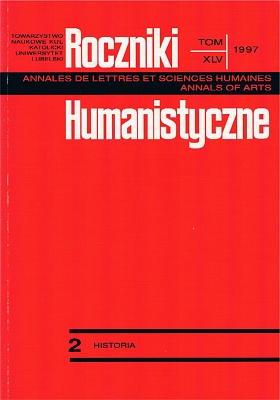Parafia Łukowa w okresie przedrozbiorowym. Terytorium i struktura społeczna
Abstrakt
The parish in Łukowa was founded in 1408 by the owner of the village, Klemens coat of arms Jelita (d. 1413/14), the castellan of Czechów, and erected by the Kraków bishop Wojciech Jarzębiec in May, 1415. The parish belonged to the group of the last parishes which were established within the Wiślica provostry in the Middle Ages. Its foundation was one manifestation of foundation activity carried out by the members of the Jelita family, an influential family in the fourteenth and at the beginning of the fifteenth centuries. Their main base in this territory was Morsko upon Nida. Łukowa was one of the numerous estates located on the border of the Sandomierz and Kraków voivodships.
The parish in Łukowa was separated from the parish in Chomentów to which it belonged from 1331. Before that date it was part of the parish in Kije from mid-12th century. Initially, the parochial district of Łukowa was small; it encompassed first only Łukowa and Ostrów (mid-15th and 16th c.). In mid-16th c. (c. 1551), following the decision of Baltazar Łukowski, the owner of the village and patron of the church, to join the Reformation adherents, the parish fell into the hands of Protestants, who owned it for almost seventy years. Reactivated c. 1620 the parish worked incessantly till the end of the period in question (the end of the 18th c.) In the 17th c. the territory of the parish increased considerably. It was then that it encompassed Chmielowice (before 1664 it belonged to the parish of Lisów), Wolica and Siedlce (before 1661, earlier in the parish of Mokrsko) and Kawczyn (before 1679). (See the map).
From the time of its establishment till the end of the 18th c. it belonged to the Kije decanate, the latter being part of the Wiślica provostry in the 15th and 18th c., and in the 16th-17th c. to the Kraków archdecanate. The area occupied by the Kije decanate in the whole period under discussion remained within the borders of the Sandomierz voivodship. The parish of Łukowa was situated in the administrative unit of Chęciny.
The establishment of a parochial centre in Łukowa is placed within a broader context of the development of settlements. In the 14th and 15th centuries settlements spread to the northward and north-eastward from the densely populated territories on the left bank of the Vistula, in the lower part of the Nida basin.
During the period of the foundation of the parish Łukowa village was part of a greater complex which belonged to the estate of the castellan Klemens. We may number him among the magnates. The social status of the succeeding generations of the village owners is successively belittled. In the 16th c. two successive owners of Łukowa, Mikołaj the cup-bearer of Sigismund I, and his son, Baltazar Łukowski, a very active politician and Seym member. In less than a hundred years later, in mid-16th c., the name Łukowski disappears from a source material. Łukowa, similarly as other places from the parish territory, becomes the seat of lower nobility getting poor. In mid-18th c. Anna Szaniawska owned the parochial village. In 1753 she founded a new church. In the end of that century it belonged to the Bajor family.
The number of population in the 15th and 16th c. may only approximately be estimated. Around 1470 almost 70 people lived in Łukowa, in 1540 the community of the parish numbered more than 170 people (c. 90 in Łukowa and at least 82 in Ostrów). Fuller data about the number of people we may found in the sources of 1664-1787. The parish had the highest demographic potential in the 1660s and 1670s. At the end of that century we notice a decrease in the number of inhabitants; in 1747 they numbered less than 500. From that time on, however, the population growth increases. As a result the number of people increases within forty years to the level from the second half of the 17th c., that is to more than 800 people. (See the table).
The structure of religion and nationality in the parish was generally uniform, except for a small group of Protestants in the second half of the 16th c. and in the beginning of the 17th c., a Jewish community recorded from mid-18th c. (two families in 1747; 36 people in 1787). Fuller data on the structure of the rural community are found only in two cross-sectional sources of 1470 and 1540. There are no data about the crucial period after the parish had been reactivated (17th-18th c.), when we observe here a considerable territorial and demographic development.
Copyright (c) 1997 Roczniki Humanistyczne

Utwór dostępny jest na licencji Creative Commons Uznanie autorstwa – Użycie niekomercyjne – Bez utworów zależnych 4.0 Międzynarodowe.





